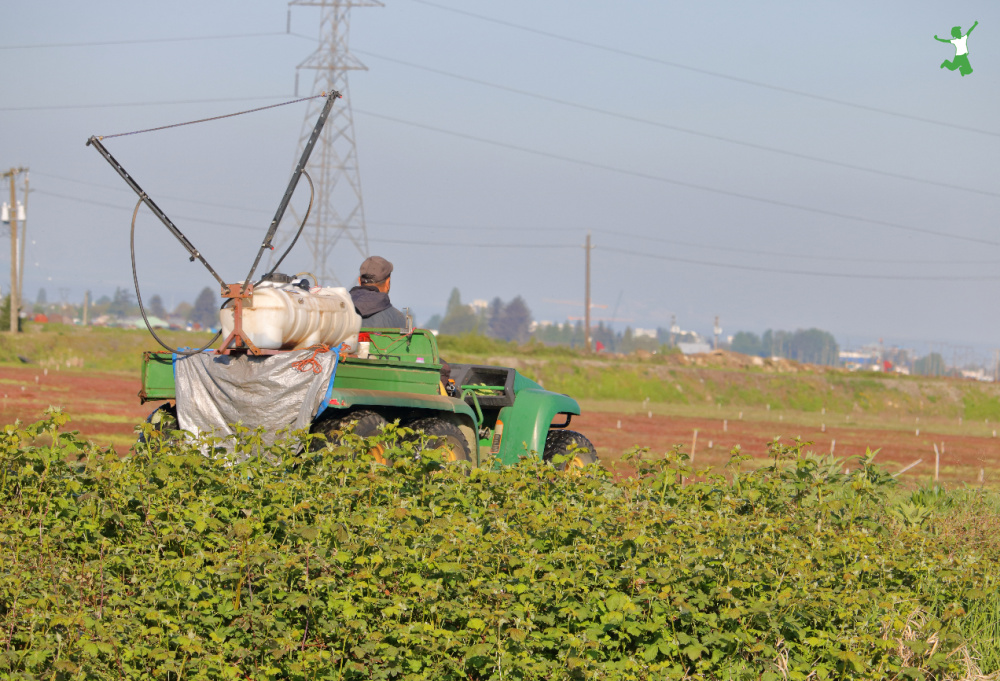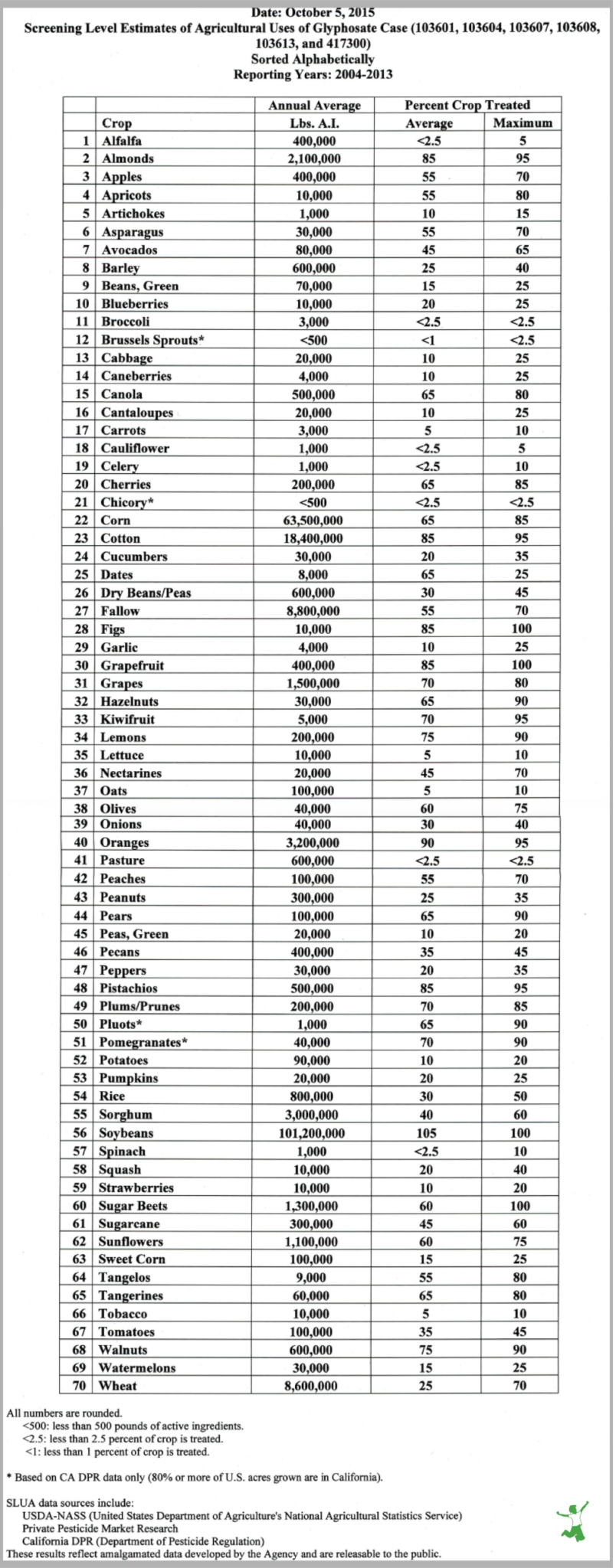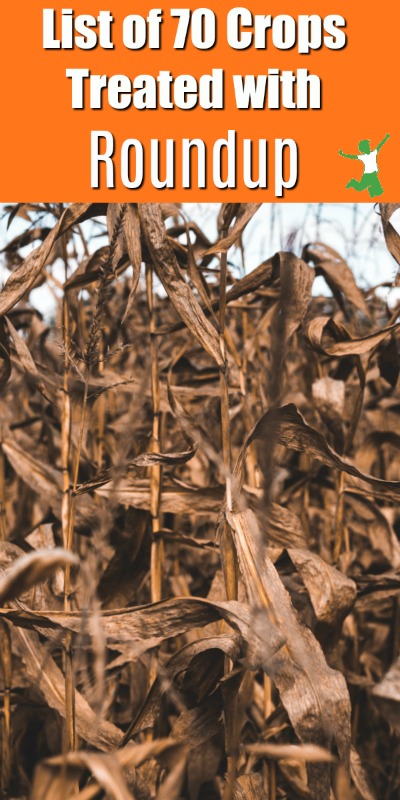Application of herbicides containing the toxic chemical glyphosate (Roundup) is common for dozens of conventional food crops, in many instances, just before harvest. The problem is not just wheat crops as commonly believed.

The application of herbicides as a (toxic) drying agent on wheat immediately before harvest is an established practice on many conventional farms.
The method was first suggested as early as 1980, becoming routine in North America over the past 15 years or so. Use is also widespread in the UK.
Applying herbicides like Roundup 7-10 days before harvest is viewed as especially helpful for wheat that ripens unevenly, a common occurrence.
It is also considered a helpful tool to initiate an earlier harvest when weather conditions threaten plant viability.
Other benefits are earlier ripening for earlier replanting and reducing the green material in the field. This puts less strain on farm machinery during harvest.
Farmers euphemistically call the practice “desiccation”. When used during wheat harvesting, it can result in a slightly greater yield by triggering plants to release more seeds.
The result?
Most non-organic wheat in North America is now contaminated with glyphosate, the active ingredient in Roundup and similar herbicides.
Glyphosate is Carcinogenic
A March 2015 report by the World Health Organization identified glyphosate as a probable human carcinogen. (1)
Several EU countries have banned Roundup as a result.
However, in North America, glyphosate use shockingly continues to remain popular in the conventional farming community.
As it turns out, the use of Roundup as a drying agent on wheat prior to harvest is just the tip of the iceberg.
Dozens of other food crops are subjected to dousing with glyphosate just prior to harvest as well.
This misguided and dangerous practice maximizes the herbicide residue on the food itself for the humans that eventually eat it!
Roundup. Not Just for GMO Crops
It is well known that Roundup is sprayed directly on GMO crops like corn and soy because they are genetically engineered to withstand the toxic onslaught without withering.
In fact, so much Roundup is used on GMO crops that herbicide-resistant “superweeds” are now a huge problem little more than a decade later. (2)
“If Roundup kills plants that aren’t genetically modified to resist it, then why use it on nonGMO crops?”
“Wouldn’t glyphosate kill a nonGMO crop?”
“Why would a farmer do this?”
Indeed, these common consumer questions indicate the ultimate irony of using Roundup for desiccation purposes on a food crop producing farm.
Killing the crop and/or the greenery around it is actually the whole idea. For crops like wheat, it evens up the field, allows for an earlier harvest, protects machinery and/or increases profit.
The bottom line?
Pre-harvest treatment of crops with glyphosate helps farmers to harvest their crops more efficiently and at less cost.
Crazy as it may seem, Roundup is used everywhere in the North American conventional food supply and not just on GMO crops or to kill weeds!
Glyphosate is applied directly to dozens of nonGMO food crops, in many cases, right before they are harvested.
This is the worst possible time to apply a herbicide because it causes the glyphosate to be absorbed into the food crop directly.
In other words, the glyphosate can’t be washed off later as it has become part of the food.
This toxin will then be ingested by those who consume it either directly as a “whole food” or via processed foods that contain it as an ingredient.
According to the Cornucopia Institute:
Ubiquitous in food production, glyphosate is used not just with row crops like corn, soybeans and wheat but also a range of fruits, nuts and veggies. Even spinach growers use glyphosate. (3)
Desiccating crops with herbicides before harvest is catching on in the UK as well where summers are wet and crops may ripen slowly and unevenly.
This can potentially lead to reduced yields and a lower-quality crop.
For example, 78% of the UK oilseed rape crop (similar to canola) is desiccated before harvest, but only 4% in Germany. (4)
Common Crops Desiccated with Glyphosate
The list of common crops desiccated with glyphosate within a few days of harvest is shockingly long!
Seventy crops are on the current EPA list which runs from 2004-2013. The complete list of crops is shown in the images below taken from an EPA memo from October 2015. (5)
What’s more, when the list is compared with a prior data snapshot, it shows that glyphosate use by farmers for key food crops alarmingly continues to grow. (6)
Glyphosate use by farmers averages 70% or more for some crops.
These include almonds, walnuts, figs, plums, prunes, grapes, kiwi, lemons, grapefruit, pistachios, and pomegranates.
Note: I could not find a more recent list than 2004-2013. However, given the results of glyphosate testing by Moms Across America in the past couple of years, it seems the list has expanded rather than contracted! More on this below.

How Glyphosate Destroys the Immune System
The currently accepted view is that glyphosate is not harmful to humans or any mammals.
This flawed view is so pervasive in the conventional farming community that Roundup salesmen have been known to foolishly drink it during presentations!
Just because Roundup doesn’t kill you immediately doesn’t make it safe though! The health-robbing effects are actually slow and insidious over months and years.
The decline in health occurs because glyphosate lethally disrupts the shikimate pathway found in beneficial gut microbes.
This probiotic pathway is responsible for the synthesis of critical amino acids and the cytochrome P450 (CYP) enzymes.
CYP enzymes are used by the body to detoxify the multitude of foreign chemical compounds and xenobiotics.
No matter where we live, we are exposed to these toxins in our modern environment every single day.
As a result, people exposed to glyphosate residue through the ingestion of food crops treated with it just before harvest become even more vulnerable to the damaging effects of other chemicals and environmental toxins they encounter!
This is possibly the worse result of glyphosate exposure. It makes you a sitting duck for any other toxins you encounter.
In addition, by significantly disrupting the functioning of beneficial bacteria in the gut, permeability issues related to the intestinal wall can occur over time.
This slow degradation of gut function encourages the development of a myriad of autoimmune disease symptoms.
These diseases include celiac disease, food allergies, Crohn’s, IBS, asthma, ulcerative colitis, MS, lupus, eczema, cancer, and the list goes on and on.
Glyphosate Million Dollar Question
Hence the chicken and egg question:
Is gluten in the wheat really the problem or is it actually the glyphosate residue sprayed on the wheat?
The same can be said for other foods.
Is it really the food(s) that are triggering an autoimmunity problem or the glyphosate that is being sprayed on it?
How Much Roundup Residue Are We Eating?
Consumers are increasingly alarmed by the monstrous rise in the use of glyphosate-containing herbicides on food crops.
In the United States, they are calling for testing of residues to determine if the levels are safe. Such testing is done for other agrichemicals, why not Roundup?
Unfortunately, while the FDA supposedly began testing for glyphosate residue in food in 2016, the results are questionable at best. (7)
Fortunately, private groups are filling the data gap, and the results are eye-opening.
For example, Moms Across America has found shocking levels of Roundup residue in processed food. Most recently, chickpea pasta was tested with the highest amount of glyphosate ever recorded. (8)
Note that chickpeas aren’t even on the Roundup crop list above 🤯
Thus, the complete list of foods with gut-damaging Roundup residues is far longer than believed.
The reality is that your only protection is to insist on organically produced food as much as possible.
And….for non-organic produce, be sure to buy it from local farmers ONLY with whom you are familiar with their growing practices.
The list of crops desiccated with glyphosate is far too long (and seemingly more extensive than is being revealed) and the risk to health far too high to consider otherwise.
(1) Widely Used Herbicide Linked to Cancer
(2) EPA Watchdog to Investigate Monsanto GMOs and Superweeds
(3) How Widespread Is the Use of Glyphosate in Our Food Supply?
(4) Glyphosate Renewal Group
(5) EPA Memo: Updated Screening Level Usage Analysis (SLUA) Report for Glyphosate Case PC
(6) EPA Memo: Updated Screening Level Usage Analysis (SLUA) Report in Support of Registration Review of Glyphosate
(7) FDA to Start Testing for Glyphosate in Food
(8) Moms Across America: Data on Toxins









The use of glyphosate simply to make it easier to harvest a crop is extremely despicable. We ought to have a law that says any farm that uses glyphosate for that purpose will be shut down on the spot! The concern from both the herbicide industry and the farming industry is all about selfish financial gain. There is a total lack of concern on their part about the horrifying health consequences that result when humans or animals eat this poison in such sky-high doses.
One recommendation I would make to all Americans is REFUSE to buy most food which is grown in the USA. You can count on foods grown in the United States to have much higher doses of this poison than foods grown anywhere else. Refusing to eat GMOs does not by itself come anywhere close to protecting you from this dangerous poison. Many non-GMOs are sprayed with enormous amounts of this poison shortly before harvest to INTENTIONALLY make the plants containing fruit or seeds die! That makes it easier to harvest they say.
Buying organic isn’t all that reliable. Many organic foods are grown close enough to crops that are treated with glyphosate to permit the wind to blow the poison over. Also some organic foods are grown on the same soil previously used for crops treated with glyphosate.
Avoid grains, beans, and peas like the plague if they are not organic and are grown in the United States. Grains and legumes often contain far more glyphosate than other food crops.
Spraying glyphosohate on fruit and nut trees would kill the tree. I don’t understand why your chart shows it in the fruits?
Could this be the actual cause of the sudden increase of people who are sickened by wheat and other grains? Wheat has been a staple for thousands of years. I find it hard to believe that wheat, by itself, is suddenly making so many people sick. I thought perhaps it was mold on the wheat (and have suspected that when I see mold on peanuts and wonder if many peanut allergies are caused by mold). After reading of the crops treated with a chemical (any chemical) prior to harvesting makes me wonder if that’s the cause. Surely it’s not somehow washed off the food before it’s ingested.
Concerned about my neighboring farmer’s Round Up use: have requested that they text before they spray so I can close my windows, take my 5 year old great niece swimming and be out of the yard…
For this spraying on August 16, 2018 (No text, No notice) I would have l covered my cucumber patch since they had just started producing.
We have a 5 acre parcel on the SE corner of his field with the prevailing winds from the NW. A day after the spraying, the cucumber leaves were black. Not yellow or brown from frost, or lack of rain; they were black. The potatoe tops are also dying off (same potatoe variety – different patch are still green) and the pea vines are dying – with blossoms and peas still on.
It is very discouraging to have a whole garden needing harvesting and feeling like I should, for health reasons, pull it all out and throw it over the fence into his wheat field. Probably should also talk to Alberta Agriculture and a lawyer.
I’m a little confused by the article and chart. FIrst of all how can one treat 105% of the soybean crop with any chemical? I am a potato grower and I am familiar with dessicants and glyphosate. Gyphosate kills plants by killing the root. Potatoes are a root crop since the tuber forms underground. If glyphosate is applied to the plant either deliberately or inadvertently, it will ruin the tubers. Even a minute amount that drifts onto the field from a neighboring field that is being sprayed can cause the tubers to become misshapen. I know of no one who would spray glyphosate on a potato field.
We keep hearing about Franken weeds that become tolerant to glyphosate and can’t be killed. Any responsibil farmer uses a combination of pesticides to prevent this from happening. Wether it’s insects, diseases or weeds, Mother Nature has a way of developing tolerances to the pesticides we use.
Thanks for the info. FYI the Amazon ads that appear on my computer are all for roundup and glyphosate. Quite distressing.
Amazon shows ads based on what the article is about … yes, quite distressing! Sorry about that! For other articles, the product ads are quite helpful.
Roundup in farm vegetables, tho a real problem, isn’t the only source of it in our diets. Consider that virtually all commercial animals processed for retail market are fed Roundup contaminated foods (corn, soybeans) to fatten them up prior to processing for retail sell through our local markets. Has anyone done research on the concentration of the chemical in those products, or evaluated the health effects of Roundup on those animals prior to processing? Seems almost impossible today to totally eliminate it from our diets. Also I’ve attempted 6 times to forward ur article by email to family & friends, only to have the Email disappear from the screen & have a blank screen appear. Censorship occurring?
This is a good article! Now, I’m a little confused about the list vs. EWG’s Dirty Dozen and Clean Fifteen lists. The Clean Fifteen list on ewg.org include some of the produce listed in here as possibly being sprayed with Roundup before harvest. I wonder why they fall under Clean Fifteen?
What the EWG list means is that the “clean 15” are sprayed less than others. They are still likely sprayed though!
Thank you for this article! A couple of years ago, I asked our “egg farmer” what they fed their chickens and they said, non-GMO feed that they got from a different farmer. Well I called that farmer and asked what they did with their feed. They said that they sprayed their land with Roundup and other herbicides before they planted their non-GMO feed. After that, I did not go back to the same “egg farmer” I went to a farmer that feeds her chickens organic feed with no Roundup!
It pays to do your homework! Good for you!
Thanks for the great article. NOTE, the EPA glyphosate usage table you include under the heading “Common Crops Desiccated with Glyphosate” includes ALL glyphosate usage, not just dessication. Dessication is the preharvest application that leaves maximum residue.
Along with wheat and oats, glyphosate is used to desiccate a wide range of other crops including lentils, peas, non-GMO soybeans, corn, flax, rye, triticale, buckwheat, millet, canola, sugar beets and potatoes. Sunflowers may also be treated pre-harvest with glyphosate, according to the National Sunflower Association.
ecowatch.com/why-is-glyphosate-sprayed-on-crops-right-before-harvest-1882187755.html